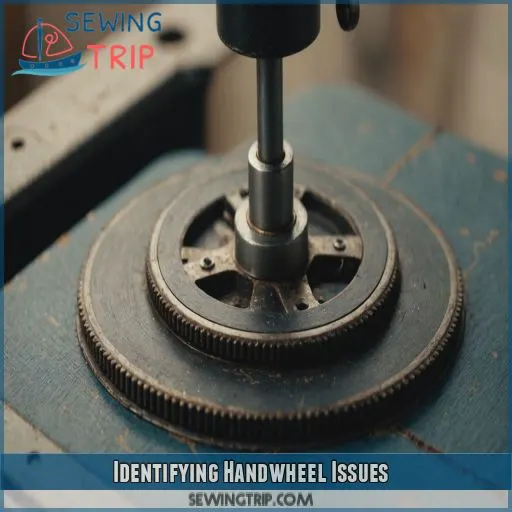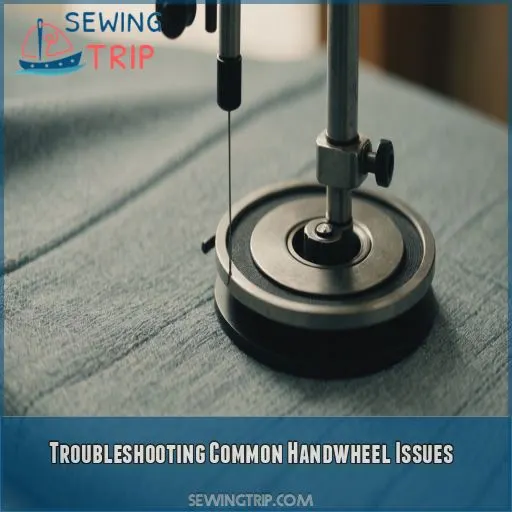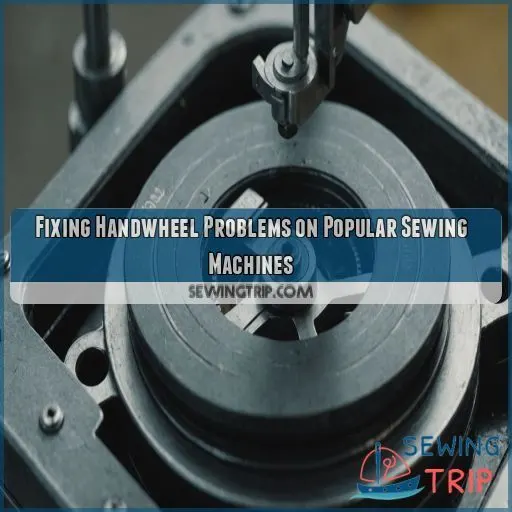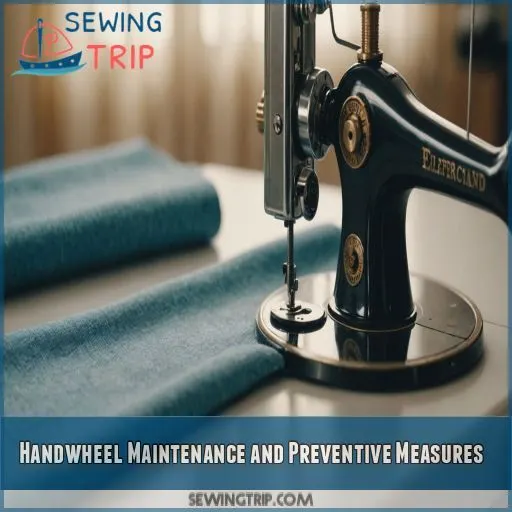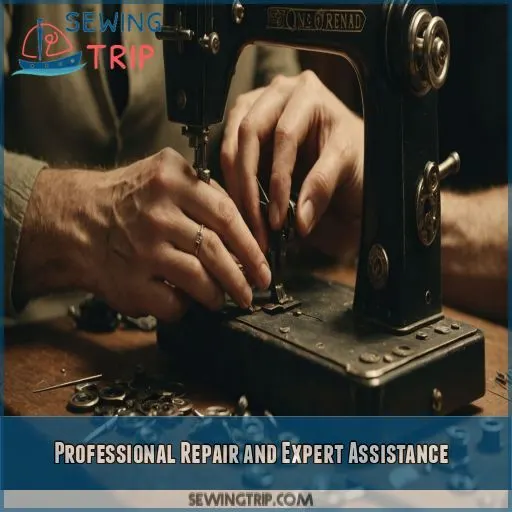This site is supported by our readers. We may earn a commission, at no cost to you, if you purchase through links.

Start by checking for thread jams or debris around the handwheel.
A good cleaning and oiling might solve the problem.
If the handwheel is still stuck, inspect the bobbin area and tension settings.
Bent needles or loose parts could also be the cause.
For brand-specific fixes, Brother machines often need a gentle brush, while Singer handwheels might need a bobbin area check.
If you’re still stumped, don’t hesitate to call in a professional.
Ready to become a handwheel hero?
Table Of Contents
- Key Takeaways
- Identifying Handwheel Issues
- Troubleshooting Common Handwheel Issues
- Fixing Handwheel Problems on Popular Sewing Machines
- Handwheel Maintenance and Preventive Measures
- Overcoming Handwheel Obstructions and Snags
- Professional Repair and Expert Assistance
- Frequently Asked Questions (FAQs)
- Conclusion
Key Takeaways
- You’re not alone in your handwheel woes! Start by checking for thread jams or debris – a good cleaning and oiling might be all your machine needs to get back in the groove. It’s like giving your trusty stitching companion a spa day!
- Don’t let a stuck handwheel unravel your sewing dreams. Inspect the bobbin area and tension settings, and keep an eye out for bent needles or loose parts. Remember, different machines have different quirks – Brother machines might need a gentle brush, while Singer handwheels could be craving a bobbin area check.
- Regular maintenance is your secret weapon against handwheel headaches. Clean and lubricate your machine every 3-4 months, or after 50 hours of sewing. It’s like giving your car an oil change – a little TLC goes a long way in keeping things running smoothly!
- If you’ve tried all the DIY tricks and your handwheel’s still giving you grief, don’t be afraid to call in the cavalry. A professional technician can spot issues you might miss and keep your machine purring like a kitten. After all, sometimes even the most seasoned sewists need a little expert help!
Identifying Handwheel Issues
When your sewing machine’s handwheel gets stuck, it’s like hitting a roadblock in the middle of a project – frustrating and maddening. To get back on track, let’s start by identifying the common causes of handwheel issues, so you can diagnose and fix the problem with ease.
Causes of Stuck or Jammed Handwheels
Stuck with a stubborn handwheel? Don’t worry, it’s more common than you think! Causes of stuck or jammed handwheels include handwheel lubrication issues, sewing machine maintenance neglect, Thread Tension problems, bobbin area blockage, and mechanical part failure. Let’s get to the root of the problem and get your handwheel turning smoothly again.
Signs and Symptoms of Handwheel Problems
Now that you know what causes stuck handwheels, let’s talk symptoms. Is your machine making weird noises or vibrating excessively? Are threads getting blocked or fabric bunching up? Maybe your stitches are uneven or skipping altogether? These are all signs of handwheel problems. If your handwheel is hard to turn or your machine’s jamming, it’s time to troubleshoot.
Types of Sewing Machines Prone to Handwheel Issues
Regarding handwheel issues, some sewing machines are more prone to problems than others. Here are 4 types to watch out for:
- Mechanical Sewing Machines: Simple, yet finicky, these machines can jam easily.
- Computerized Sewing Machines: High-tech, but delicate, their handwheels can malfunction with ease.
- Heavy-Duty Sewing Machines: Built for tough jobs, but their handwheels can lock up under stress.
- Vintage Sewing Machines: Oldies but goodies, their handwheels can be stubborn and tricky to fix.
Importance of Prompt Repair and Maintenance
Now that you know which sewing machines are prone to handwheel issues, let’s talk about the importance of prompt repair and maintenance. Don’t wait for a minor problem to become a major headache! Regular oiling and handwheel maintenance can save you from costly repairs and extend your machine’s life. Schedule regular tune-ups to prevent damage and reduce downtime.
Troubleshooting Common Handwheel Issues
You’re staring at your sewing machine, wondering why the handwheel won’t budge – don’t worry, it’s an easy fix! Let’s get that wheel spinning again by walking through some common issues and troubleshooting steps to get you sewing in no time.
Checking Power Source and Cables
First, let’s get the basics covered – is your sewing machine even getting power?
Check that the power cord isn’t damaged and the plug is securely inserted into a working outlet.
Verify that the electricity supply isn’t the culprit by trying a different outlet.
A faulty power connection can cause your handwheel to stall, so rule this out before moving on.
Thread Tension and Obstruction Removal
Now that you’ve checked your power source and cables, let’s tackle thread tension and obstruction removal.
If your handwheel is stuck, it’s likely due to caught thread or lint buildup.
Gently remove any excess thread, and clean your machine to prevent further issues.
Monitor your thread tension and adjust as needed to prevent needle jams and keep your machine running smoothly.
Bobbin Winding Mechanism and Bobbin Case
Now that you’ve tackled thread tension and obstruction removal, let’s move on to the Bobbin Winding mechanism and bobbin case.
Check your bobbin winding tension and clean the bobbin case regularly to prevent handwheel issues.
Make sure the bobbin case is compatible with your sewing machine and use sewing machine oil to lubricate moving parts.
If issues persist, consider a professional inspection.
Bent Needles or Broken Parts Replacement
- Replace bent needles with new ones to avoid further damage
- Source replacement parts from authorized dealers or online marketplaces
- Consider seeking professional help if you’re not comfortable with DIY repair
Fixing Handwheel Problems on Popular Sewing Machines
You’re about to tackle the most frustrating part of sewing machine ownership: the stuck handwheel. Don’t worry, we’ll help you figure it out – in this section, we’ll walk you through troubleshooting and fixing handwheel problems on popular sewing machine brands like Brother, Singer, and Janome.
Brother Sewing Machine Handwheel Repair
Fixing a stuck Brother handwheel can be a real pain. First, check for loose threads or debris. If that’s not the issue, try cleaning the handwheel with a soft brush and some sewing machine oil. If it’s still stubborn, you might need to replace it. Don’t worry, it’s an easy DIY fix that’ll have you sewing in no time.
Singer Sewing Machine Handwheel Troubleshooting
Stuck with a stubborn Singer sewing machine handwheel? Don’t worry, friend! First, check for loose threads or debris. Next, verify the needle is properly seated and the bobbin area is clear. If issues persist, try adjusting the tension or consulting a pro. Regular maintenance can prevent handwheel headaches, so schedule those tune-ups and keep your Singer singing!
Janome Sewing Machine Handwheel Issues and Fixes
Fixing your Janome sewing machine‘s handwheel issues is a breeze! Start by checking the take-up lever and tightening knob. If the needle’s stuck, try wiggling the knob or adjusting the presser foot pressure. For stubborn problems, disengage the belt and give the handwheel a good clean. Regular lubrication and maintenance will keep your Janome machine purring smoothly.
Handwheel Maintenance and Preventive Measures
You’ve mastered the art of fixing your sewing machine’s handwheel, but now it’s time to keep it running smoothly. Let’s explore some essential maintenance tips and preventive measures that’ll help you avoid future handwheel headaches and keep your sewing projects on track.
Regular Cleaning and Lubrication
Ready to become a handwheel hero? Regular cleaning and lubrication are your secret weapons!
Grab your trusty cleaning tools and tackle that pesky lint buildup. Don’t forget to remove the needle and presser foot for a thorough job.
Choose the right oil type for your machine and hit those key lubrication points. With a little TLC, you’ll keep your sewing sidekick purring like a kitten.
Monitoring Thread Tension and Adjusting
Keeping your sewing machine’s thread tension in check is like finding the perfect balance on a seesaw. It’s essential for smooth handwheel operation and flawless stitches. Watch for these telltale signs of tension trouble:
- Loops on the underside of your fabric (Oops, too loose!)
- Puckered seams that look like a grumpy face (Yikes, too tight!)
- Skipped stitches playing hide-and-seek (Time to investigate!)
- Fabric that’s as stressed as you on a Monday morning (Adjust ASAP!)
Disengaging Belt and Turning Handwheel Anticlockwise
Now that you’ve mastered thread tension, let’s tackle another important maintenance trick: disengaging the belt and turning the handwheel anticlockwise. This simple yet powerful technique can prevent damage and keep your machine purring like a contented cat. Here’s a quick guide to help you become a handwheel whisperer:
| Step | Action | Benefit |
|---|---|---|
| 1. Unplug | Safety first! | Prevent accidents |
| 2. Locate belt | Find the side panel | Access internals |
| 3. Disengage | Gently loosen belt | Reduce stress on parts |
Scheduling Professional Maintenance
While regular DIY maintenance is essential, don’t forget to schedule professional tune-ups. A skilled technician can spot issues you might miss and keep your machine purring like a kitten. Here’s why professional maintenance is worth its weight in gold:
- Extends your machine’s lifespan
- Catches small problems before they become big headaches
- Guarantees peak performance for all your sewing projects
- Maintains warranty coverage
- Provides peace of mind for serious sewists
Overcoming Handwheel Obstructions and Snags
Is your sewing machine’s handwheel giving you grief? Don’t fret – we’ll show you how to tackle those pesky obstructions and snags that can turn your smooth-running machine into a stubborn mule.
Removing Excess Thread and Debris
Got a stubborn handwheel? Let’s tackle those pesky threads and debris!
First, unplug your machine and grab your trusty lint brush. Gently sweep away any visible fuzz around the bobbin area.
For those hard-to-reach spots, use tweezers to extract tangled threads. Don’t forget to clean your bobbin case too – it’s like giving your machine a spa day!
Regular cleaning will keep your handwheel spinning smoothly.
Avoiding Overheating and Reducing Friction
Now that you’ve cleared out the debris, let’s tackle overheating and friction. These pesky problems can turn your sewing machine into a hot mess faster than you can say "bobbin"!
To keep things cool, give your machine regular breaks during long sessions.
Choose the right lubricant for your model – it’s like picking the perfect oil for your car. And remember, smooth-running parts are happy parts!
Professional Repair and Expert Assistance
When your DIY fixes just won’t cut it, it’s time to call in the pros for your sewing machine woes. Let’s explore when to seek expert help, how to find trustworthy technicians, and why professional maintenance can be a real game-changer for your trusty stitching companion.
When to Consult a Sewing Machine Technician
When your sewing machine’s handwheel is giving you more grief than a tangled ball of yarn, it’s time to call in the cavalry.
If you’ve tried the DIY fixes and your machine’s still acting up, don’t sweat it. Persistent issues, error messages, electrical problems, or unusual noises are signs it’s time for expert eyes.
Complex repairs require a pro’s touch, so don’t be afraid to seek help.
Finding Verified Experts and Repair Services
- Check online directories for certified technicians
- Ask fellow sewists for recommendations
- Look for repair services with high ratings and reviews
- Consider response time and availability
- Compare costs and location options
Benefits of Professional Maintenance and Repair
Now that you’ve found a trusted expert, let’s talk about the perks of professional maintenance.
Think of it as a spa day for your trusty sewing companion!
Regular check-ups can extend your machine’s life, saving you big bucks in the long run.
Plus, you’ll get expert advice specific to your model.
Don’t forget the peace of mind that comes with warranty protection – it’s like a safety net for your stitching adventures!
DIY Repair and Troubleshooting Limitations
DIY repairs can save you money, but they’re not always easy.
You might run into trouble if you don’t have the right tools or knowledge.
Keep in mind that working on your machine yourself could void its warranty.
When in doubt, it’s best to call a professional technician.
They have the expertise to handle complex issues and keep your sewing dreams alive.
Frequently Asked Questions (FAQs)
Why is my sewing machine handwheel not moving?
Your handwheel might be stuck due to thread jams, debris buildup, or improper needle installation. Don’t panic! Start by checking for visible obstructions, then clean the area and verify everything’s properly threaded. You’ll be stitching smoothly in no time!
Why is my sewing machine motor not spinning?
With 9 million users worldwide, you’re not alone in this! Your sewing machine motor might be stuck due to a loose belt, jammed thread, or electrical issue. Check connections, clear debris, and oil moving parts. Still stumped? A pro can help!
Why is my sewing machine locked up?
Your sewing machine’s locked up? Don’t sweat it! It’s likely a thread tangle or debris buildup. Check the bobbin area, clean out any fuzz, and make sure your needle’s properly installed. A little TLC can get you stitching again in no time!
How do you fix the handwheel on a Brother sewing machine?
You’ve got this! First, unplug your Brother machine. Clean the handwheel area, removing any lint or thread. Apply a drop of sewing machine oil to moving parts. Gently turn the wheel to distribute the oil. If it’s still stuck, seek professional help.
How often should I oil my sewing machine handwheel?
You’ll want to oil your handwheel every 3-4 months, or after 50 hours of sewing. It’s like giving your trusty machine a spa day – a little TLC goes a long way in keeping things running smoothly!
Can a faulty motor affect handwheel performance?
You’re threading your machine when suddenly, the motor sputters. Coincidentally, your handwheel’s acting up too. Yes, a faulty motor can affect handwheel performance. It’s like a car’s engine impacting the steering wheel. Time for a tune-up!
Is it safe to force a stuck handwheel?
No, don’t force that stubborn handwheel! You’ll risk damaging your trusty sewing companion. Instead, gently wiggle it back and forth while checking for thread tangles. If it’s still stuck, it’s time to call in the pros.
What tools are needed for handwheel repairs?
You might think you need a toolbox full of gadgets, but you don’t! For handwheel repairs, you’ll need a screwdriver, pliers, and a cleaning brush. Don’t forget sewing machine oil and a lint-free cloth for maintenance.
How do different fabric types impact handwheel operation?
You’ll notice heavier fabrics like denim can make your handwheel tougher to turn. Lighter materials like silk? It’s smooth sailing! Keep an eye out for fabric thickness and adjust your machine’s tension accordingly. It’s like fine-tuning your sewing symphony!
Conclusion
You’ve made it through the handwheel maze, armed with DIY tricks and expert fixes for sewing machine handwheel issues. You’re now a certified thread whisperer.
Regular maintenance is key to keeping your machine purring like a kitten.
But if your handwheel’s still giving you the cold shoulder, don’t be afraid to call in the pros. After all, fixing sewing machine handwheel issues isn’t just about saving your machine – it’s about preserving your sanity.

